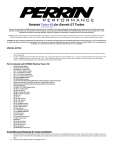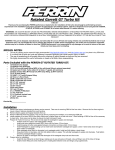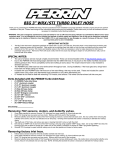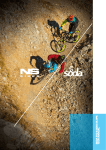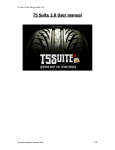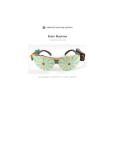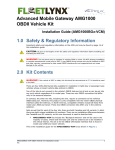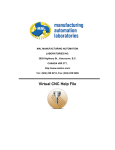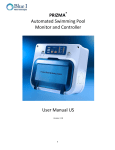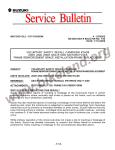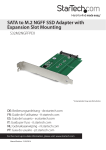Download Rotated Turbo Kit - Perrin Performance
Transcript
08+ Rotated Tuner Kit for Garrett GT Turbos 11311 Thank you for purchasing the PERRIN performance rotated turbo kit. Installation of this turbo should only be performed by persons experienced in the installation and proper operation of turbochargers and related systems. This kit is designed around using Garrett GT3071R, GT3076R, and GT3582R (utilizing Garrett T3 turbine housing with 3”, 4 bolt discharge) and Tial 44mm v-‐band style wastegate. Neither the wastegate or turbocharger is included and must be purchased separately. Warning: An accurate boost gauge and programmable engine management, is required for proper installation and adjustment of this product. Improper installation, tuning and use of this product will damage the engine and may result in injury or death! PERRIN performance is in no way responsible for any damages as a result of the installation of this product! These turbos are designed to make more power than your engine is designed for. WARNING: This part is designed, manufactured, and sold solely for use on off-‐road and racing vehicles not controlled by federal and or local emissions laws. It is not intended for use on vehicles that operate on public streets and highways. Use of this part on emissions controlled vehicles may be in violation of federal or local law! ASMC, LTD. is not responsible for any damages as a result of misuse of this part. Check your local laws prior to use or installation. SPECIAL NOTES: • • • • The use of a factory service manual is highly recommended. http://techinfo.subaru.com. It is critical that all bolts and nuts are tightened; improper tightening can cause damage or serious injury/death. The use of penetrating oil will greatly reduce the chances of galling threads on bolts as they are removed. We highly recommend the use of anti-‐seize on treads of all bolts, when reassembling. This part is designed to work best with a Blow-‐Thru Boost Tube, or Stand alone ECU that removes the MAF sensor. If a tuner is unfamiliar with Blow-‐Thru boost tube, we also include our Standard MAF housing and a reducer coupler. This is a more traditional style of intake system and it would be installed on filter side of intake tube using supplied coupler. Take note that this requires a Vent to Atmosphere Blow off Valve to be installed. • • • • • • • • • • • • • • • • • • • • • • • • • • • • • • • • • • • • • • • • (1) Rotated Turbo Uppipe (1) Rotated Turbo Downpipe (1) Aluminum 3” Turbo Intake (1) 3”-‐4” Silicone Reducer coupler (1) 2”-‐2.25” Silicone Jog coupler (1) 2.75”-‐3” Silicone reducer coupler (1) 3.125”ID PERRIN 2pc Filter (1) PERRIN Standard MAF housing (1) STI oil line with female fitting (WRX oil line with banjo fitting is ordered separately) (1) Gasket set (T3 inlet, Turbo outlet, GT oil drain, 3” gasket, (2) restrictors) (2) Banjo Coolant Sets (M14 banjo bolt, M14 banjo fitting, (2) M14 washers) (1) GT oil drain flange (1) 3/8NPT-‐ 1/2” barb 45 degree fitting (1) 02 Sensor bung (4) 10mm x 1.25mm Studs (4) 10mm x1.25 Nuts (2) M8 x 20 Socket cap screws (4) M8 x 25 Socket cap screws (1) 5/32” tee (1) 1/2” tee (2) 1/2”-‐3/8” reducers (2) 1/2”-‐5/8” reducers (1) 3/8” connector (2) 1/2” straight connector (1) 3/8” Straight connector (1) 3/8”-‐5/16”connector (1) T-‐bolt 175 size (3’) –10 PERRIN PYROshield (2’) –12 PERRIN PYROshield (7’) 1/2” Fuel hose (2’) 1/4” fuel hose (3’) –6 Pushlock coolant hose (7’) 5/32” vacuum hose (20) Zip ties (1) Size 64 hose clamp (5) Size 48 hose clamp (1) Size 36 hose clamp (2) #3 hose clamps (2) M4 Phillips pan head screw Parts Included with PERRIN Rotated Tuner Kit: Assembling and Preparing for Turbo Installation 1) Remove the factory turbocharger per factory service manual. Take care in removing OEM oil line from turbo. Remove this line from engine to insure it doesn’t become stressed from over bending. Keep track of both coolant lines, and the oil drain hoses as these connection points are going to be reused later. 2) 3) 4) 5) 6) Remove factory Uppipe bracket and Uppipe from car. Remove OEM inlet hose from engine. This can be done by removing the manifold, or by destroying OEM part. Install supplied oil line onto OEM oil line fitting. Make sure to tighten down or oil leak can occur. Some bending of OEM oil line will be necessary to clear turbo. Extra care must be taken to ensure the hard line doesn’t break. Wait to bend line once turbo is ready to drop into engine bay. Prepare for Turbo kit mock up. This is done to help align the wastegate to uppipe and downpipe. • Install 4 studs into uppipe, and install gasket to flange. • Install turbo onto uppipe and install 10mm nuts, but leave 1/2 turn loose. • Install downpipe to turbo (using gasket between connection), and leave M8 bolts 1/2 turn loose. • Install Wastegate to uppipe making sure to install valve seat between wastegate and uppipe. Leave v-‐band clamp loose enough to allow rotation of wastegate. (Use of Anti-‐Seize on inside of clamps can aid in installation) • Slide wastegate dump tube (on downpipe) up to wastegate outlet. Install and fully tighten v-‐band clamp. • Snug down bolts on downpipe, and then fully tighten bolts on uppipe. This will align wastegate to uppipe and downpipe. Fully tighten remaining wastegate flange to uppipe. • Remove (4) bolts on downpipe and slide downpipe off of wastegate dump tube and from turbo. Prepare to clock turbo for installation. • Install Oil drain fitting into oil drain flange, making sure to use anti-‐seize or Teflon paste on threads. Line up fitting to one of the holes in flange. This fitting is an NPT type fitting and seals using the taper in the threads. Thread fitting in by hand and turn an addition 2-‐2.5 turns with a wrench to seal properly. • Install oil drain fitting onto turbo making sure to install gasket between turbo and flange using supplied bolts. Make sure and place drain so outlet points away from the flange as in the picture. • Re-‐clocking (rotating the housings to line up) is required to align compressor/center housing, and turbine housing. Loosen bolts on outside turbo (6 bolts on the compressor, and 6 on the turbine). Rotate center section until brass drain fitting hits the uppipe flange. Rotate drain fitting roughly .25” away from flange. Tighten turbine-‐housing bolts to secure rotation. NOTE: If rotated too far away, oil will pool in turbo and cause oil consumption. This will still not be perfectly vertical, but do not worry. (SEE PICTURE) • Rotate compressor housing until compressor outlet is facing toward the throttle body, and tighten back down. Some rotation may be needed later in the install, but getting it close is necessary for installation. • Preinstall turbo/uppipe assembly to manifold to determine oil drain tube length. Simply use a couple OEM bolts to hold it to the manifold. Using supplied 1/2” hose, attach to brass fitting on turbo drain and install supplied clamp. Install included reducer into OEM oil drain tube, and cut 1/2” hose to length. • Install a short piece of PERRIN Pyroshield to drain hose making sure to cover all the way the the brass fitting. Install drain hose to reducer fitting, and install clamp. It is critical to not cause a kink in the line as it will cause pooling of oil in turbo. Turbocharger taken apart for illustration purposes only! 7) Install PERRIN uppipe to exhaust manifold making sure to use new gasket, and use OEM bolts. Do to the precise nature of the OEM exhaust manifold, you can line up the flanges of the PERRIN uppipe to and torque bolts down. If installing with other aftermarket manifold, leave slightly loose until all other parts are installed. 8) Install oil supply line to turbo oil inlet making sure to install oil line restrictors (SEE PICTURE). Special Note: Included with kit are 2 oil line restrictors, make sure to use them both as shown in the diagram. 9) Install downpipe onto turbo and wastegate dump tube. Snap into transmission hanger and install bolt loosely. Then install and tighten 4 bolts onto turbo exhaust housing. 10) Under car, tighten downpipe to tranny mount and to rear catback exhaust using supplied 3” gasket. This Downpipe requires that the installed catback has a flex joint in the pipe. If catback uses a doughnut type gasket, we recommend flipping it 180 degrees, the installing the catback. 11) Using full length of 3/8” Coolant hose, Install push-‐loc banjo fittings into both ends. Temporarily mount fittings to turbo and determine the cut length of each hose. Keep in mind that there will be 3/8”-‐1/2” reducer fittings installed to allow you to connect hoses to OEM 1/2" coolant hoses. NOTE: We 12) 13) 14) 15) 16) 17) 18) recommend installing the right side (left if standing in front of the car) hose pointing up and going to the coolant reservoir. The left side (right side if standing in front of car) pointing down going toward block then to coolant hose coming off the engine. It doesn’t matter which hose goes where as long as they are connected to the same coolant hoses the OEM turbo was connected. With hose length set, install supplied 3/8”-‐1/2” reducer fitting to ends of hose and secure with supplied clamps. With hose length set, remove coolant hoses from car. Using smaller diameter Pyroshield, cover both coolant hoses from banjo fitting all the way to the installed adapters. Install supplied clamps over banjo fitting end clamping over Pyroshield and hose at the same time. NOTE: Slide Pyroshield over banjo end is easier than installing over other end. Reinstall fittings making sure to use copper gaskets between turbo and banjo fitting, and between head of banjo bolt and banjo fitting. Align fittings to turbo and tighten to roughly 20ft-‐lbs. Install PERRIN rotated turbo intake kit and boost tube connection. (See Rotated Intake instructions below) Install boost control system to wastegate according to instructions provided with boost controller, or follow Boost Controller Hookup instructions below. If you are unsure about your boost control system, located lower port on wastegate, and connect to boost source. This will provide 14psi of boost. Start car and check for oil leaks at turbo, at the oil drain tube connection, and coolant line connections. If any leaks are found stop engine and fix. Start engine, and let it warm to normal operating temperature. Once again make sure there are no leaks. Once no leaks are found, using supplied zipties, tie coolant hoses out of way of turbo, and Pyroshield material to oil line, and power steering line. Extra Pyroshield is included for covering misc wires and harnesses. Cold Air Intake System Installation 1. Prepare coolant reservoir tank to be relocated by either draining some coolant from the system, or by using pinch-plyers and cap to contain coolant from spilling everywhere after hoses are removed. 2. Unbolt coolant reservoir from intake manifold, while removing upper and lower coolant hose (leave lower hose connected to pipe under intake manifold). Relocate coolant reservoir to front bolt that was securing it to the intake manifold. 3. Using supplied 1/2” connector and roughly 9” of 1/2” hose, connect bottom port of coolant reservoir to OEM 90-degree hose left on pipe under intake manifold. Hose on pipe will need to be rotated toward front of car to line up better with new placement of coolant reservoir. 4. Use OEM pinch clamps and supplied #3 hose clamps to secure hoses to fitting and to tank. 5. Install 3”-4” reducer coupler onto turbo, and loosely install hose clamps. (Removal of FMIC boost tube is necessary if already installed). 6. Install intake pipe into turbo coupler, leaving clamp loose. Route intake pipe down through hole where OEM intake used to reside. Pipe will be close to engine, coolant reservoir, and ABS brake lines, take time in adjusting tube to fit. 7. Install intake bracket to chassis in hole OEM intake was bolted to. Leave bolt loose until filter is secured and installed. This bracket gets installed under clamp of filter. 8. Install filter to intake tube and loosen hose clamp enough for bracket to fit under clamp. Once complete intake is adjusted to your liking, tighten clamps securing filter and intake tube to turbo inlet. 9. Locate crank case vent, and crank case vent hose. Remove rubber hose, and PCV diagnosis connector, from crank case junction block. 10. Locate jumper pin inside of diagnosis connector. Reach inside with needle nose pliers and remove pin. 11. Install jumper pin into electrical harness that diagnosis connector was plugged into. Tape up connection to secure pin into harness. Diagnosis connector shown with jumper pin being pulled out. Plug may be gray or white depending on year of car. 12. Install supplied 1/2” fuel hose onto crank case vent hose as indicated in below picture. Route hose to one of the 1/2” fittings on the intake hose. Tighten hose clamp to intake pipe using supplied hose clamp. 13. Located valve cover vent hose (pictured going front to back on the below pic) which goes over the intake manifold. Connect supplied hose to this junction and route to remaining 1/2" connection on turbo intake hose. This step assumes you have a Front Mounted Intercooler already installed. If you do not, the valve cover vents are the pipes on front of OEM top mounted intercooler. NOTE: If these hoses are not installed use supplied 1/2” fuel hose, 1/2” tee, and 1/2” connector, join left and right valve cover vent hoses. Reuse OEM hose for passenger side connection, and use about 24” of 1/2” fuel hose to reach drivers side. Connect the drivers side valve cover vent hose to 1/2” fuel hose using the supplied 1/2” connector. Then connect ½” hose to remaining leg of 1/2" tee and route to intake. 14. Connect remaining open tee connection to supplied 1/2” fuel hose, and route to 1/2” spigot on intake pipe. Tighten hose clamp to intake pipe using supplied small hose clamp. 15. Locate EVAP solenoid return hose. This hose connected to OEM turbo intake hose. Using supplied 1/4” fuel hose and 1/4”-3/8” adapter, connect hose to small spigot on intake pipe. This hose is indicated above in red. 16. Locate Boost solenoid return hose and remove this from the boost control solenoid. Follow below instructions on installing your boost control system. 17. Locate 2”-2.25” or 2.5”-2.25” jog coupler and connect it to your turbo and intercooler piping using supplied clamps. 18. Install filter to end of intake. If you are choosing to use pull through intake system(instead of a blow through or speed density setup) use supplied reducer coupler and clamps to secure MAF housing to intake pipe. BOOST CONTROLLER HOOKUP 1) 2) In all instances the best boost source is the intake manifold unless fitting is already installed on turbo. The best place is the small fitting at the front of the manifold that points down and goes to EVAP solenoid. Cut hose and install supplied tee and zip tie connection points. (Do not run boost gauges off this hose or incorrect readings may occur. We highly recommend against using OEM boost controllers with our kit. If OEM boost controller must be used, some extending of OEM rubber hoses will be necessary. Make sure when using OEM hoses to leave restrictor in hose going to boost source. Use below diagram to help with installation. In this application, use lower port on External Wastegate. NOTE: Intake Manifold can be uses as boost source. 3) An expectable boost controller to use with this kit is a manual type boost controller. The installation will vary with different brands. The installation of a PERRIN manual boost controller is described below. Included with the kit is enough 5/32” vacuum hose to install this boost controller. It is necessary to have a high quality boost gauge installed in order to properly adjust this. PERRIN Manual Boost Controller shown connecting to bottom port on Wastegate. NOTE: Intake Manifold can be uses as boost source. 4) The best and most accurate way to control boost is with an electronic boost control solenoid. Described below is how to use the PERRIN EBCS with an external wastegate. Included with the kit is enough hose to install a boost controller like this. The EBCS is used in conjunction with a programmable engine management system. Call with specific questions regarding initial map settings. This method allows the user to get very high boost levels, with the use of a lightweight spring. PERRIN EBCS solenoid shown connecting to External Wastegate. NOTE: Intake Manifold can be uses as boost source. Common Questions Answered • • 02+ WRX 2.0 engines with PERRIN fuel rails will have to flip the fuel rails around 180 degrees to clear silicone coupler. If this is not done, expect some interference with fuel rails and silicone turbo coupler. This intake system requires ECU tuning. Stock engine management cannot be used. Please consult a qualified ECU tuning specialist. For questions & comments please contact [email protected] 503-‐693-‐1702 See Website for Instant Chat Options






